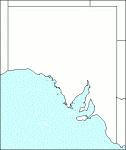Family: Iridaceae
Homeria flaccida
Citation:
Sweet, Hort. Brit. 395 (1827).
Synonymy: H. collina sensu J. Black, Nat. Fl. S. Aust. 149 (1909), non Salish.; H. breyniana sensu H. Eichler, Suppl. 88 (1965), non G.J. Lewis, a name of uncertain application.
Common name: One-leaved Cape tulip.
Description:
Perennial 20-50 cm high; corm to 2 cm diam.; leaf solitary, near-basal, 25-80 cm long, 6-11 mm wide, lax, trailing; stem few-branched, or rarely simple, with bracts 2-5 cm long.
Spathes 5-8 cm long, the outer bract half to two-thirds the inner; flowers pale-orange or less often yellow, each segment with a triangular yellow mark at the base, sickly-sweet scented; perianth-segments 2-3.5 cm long, forming a funnel-shaped cup around the stamens, spreading above; outer segments oblong to narrowly obovate; inner segments narrower, oblanceolate; filaments connate in a tube c. 7 mm long, minutely pubescent in the lower half; anthers 6-10 mm long, parallel at the base, divergent above; ovary 1.6-2 cm long; style branches 3, divergent, 5-7 mm long; stigmas broad, 2-lobed, above the anthers; style crests erect, triangular, c. 1 mm long.
Capsules 2.5-5 cm long, with a dark acute beak, 1.5-2 mm long.
Published illustration:
Parsons (1973) Noxious weeds of Victoria, p. 171.
|
|
Distribution:
|
On pastures, roadsides and disturbed ground, but never under dense tree or shrub cover.
W.Aust.; N.S.W.; Vic.; Tas. Native to the Cape Province, South Africa.
|
Conservation status:
naturalised
Flowering time: Sept., Oct.
|

SA Distribution Map based
on current data relating to
specimens held in the
State Herbarium of South Australia
|
Biology:
South Australian material here referred to H. flaccida approaches the related H. collina in its generally smaller size and in the deep, narrow cup formed by the perianth-segments. Hybridisation occurs between these species (Goldblatt (1980) Bot. Notis. 133:85-95.), and the Australian populations, which are derived from horticultural stock and have been subjected to many generations of selection in a new ecological range, may lie on a hybrid continuum between the two species.
Author:
Not yet available
|

